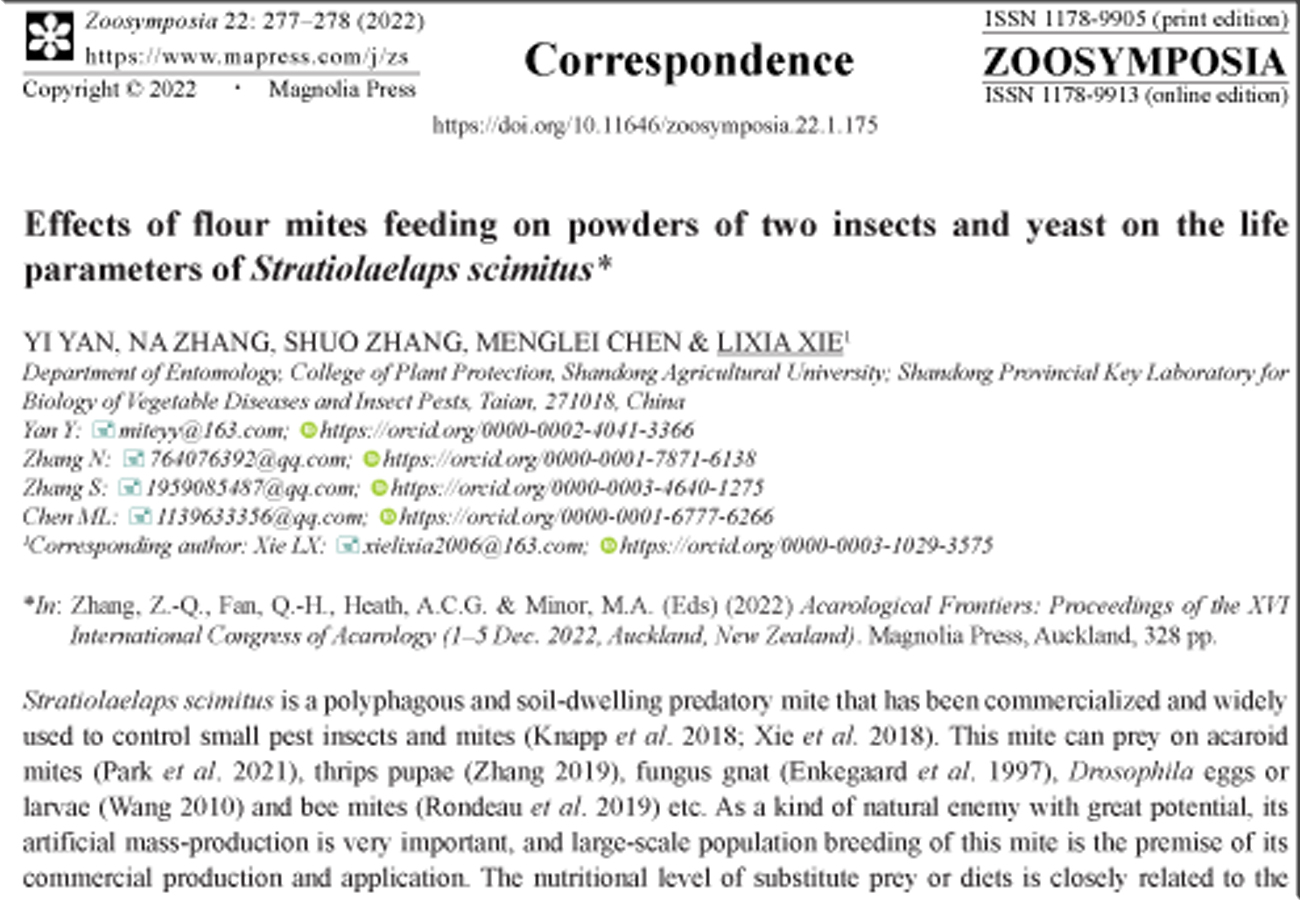Abstract
Stratiolaelaps scimitus is a polyphagous and soil-dwelling predatory mite that has been commercialized and widely used to control small pest insects and mites (Knapp et al. 2018; Xie et al. 2018). This mite can prey on acaroid mites (Park et al. 2021), thrips pupae (Zhang 2019), fungus gnat (Enkegaard et al. 1997), Drosophila eggs or larvae (Wang 2010) and bee mites (Rondeau et al. 2019) etc. As a kind of natural enemy with great potential, its artificial mass-production is very important, and large-scale population breeding of this mite is the premise of its commercial production and application. The nutritional level of substitute prey or diets is closely related to the growth, development and reproduction of predatory mites (Zhang et al. 2020; 2021). Therefore, the reproductive capacity and biological characteristics of predatory mites can be improved by improving the nutritional level of substitute prey or diets.
References
Azevedo, L.H., Leite, L.G., Chacon-Orozco, J.G., Moreira, M.F.P., Ferreira, M.P., González-Cano, L.M., Borges, V., Rueda-Ramírez, D., de Moraes, G.J. & Palevsky, E. (2019) Free living nematodes as alternative prey for soil predatory mites: an interdisciplinary case study of conservation biological control. Biological Control, 132, 128−134. https://doi.org/10.1016/j.biocontrol.2019.02.007
Chi, H (1988) Life table analysis incorporating both sexes and variable development rates among individuals. Environmental Entomology, 17 (1), 26–34. https://doi.org/10.1093/ee/17.1.26
Enkegaard, A., Sardar, M.A. & Brødsgaard, H.F. (1997) The predatory mite Hypoaspis miles: biological and demographic characteristics on two prey species, the mushroom sciarid fly, Lycoriella solani, and the mould mite, Tyrophagus putrescentiae. Entomologia Experimentalis et Applicata, 82, 135–146. https://doi.org/10.1046/j.1570-7458.1997.00123.x
Khanamani, M., Fathipour, Y., Talebi, A.A. & Mehrabadi, M. (2017) Evaluation of different artificial diets for rearing the predatory mite Neoseiulus californicus (Acari: Phytoseiidae): diet-dependent life table studies. Acarologia, 57 (2), 407−419. https://doi.org/10.1051/acarologia/20174165
Knapp, M., Houten, Y. V., Baal, E. V. & Groot, T. (2018) Use of predatory mites in commercial biocontrol: current status and future prospects. Acarologia, 58 (Suppl), 72–82. https://doi.org/10.24349/acarologia/20184275
Park, J., Mostafiz, M.M., Hwang, H.S., Jung, D.O. & Lee, K.Y. (2021) Comparing the Life Table and Population Projection of Gaeolaelaps aculeifer and Stratiolaelaps scimitus (Acari: Laelapidae) based on the age-stage, two-sex life table theory. Agronomy, 11 (1062), 1–13. https://doi.org/10.3390/agronomy11061062
Rondeau, S., Giovenazzo, P. & Fournier, V. (2019) The use of the predatory mite Stratiolaelaps scimitus (Mesostigmata: Laelapidae) to control Varroa destructor (Mesostigmata: Varroidae) in honey bee colonies in early and late fall. Journal of Economic Entomology, 112 (2), 534−542. https://doi.org/10.1093/jee/toy418
Su, J., Dong, F., Liu, S.M., Lu, Y.H. & Zhang, J.P. (2019) Productivity of Neoseiulus bicaudus (Acari: Phytoseiidae) reared on natural prey, alternative prey, and artificial diet. Journal of Economic Entomology, 112 (6), 2604−2613. https://doi.org/10.1093/jee/toz202
Wang, Z.Q. (2010) Studies on the predatory mites of Lycoriellap sp. Fujian Agriculture and Forestry University, Fuzhou, China, 73 pp
Xie, L.X., Yan, Y. & Zhang, Z.Q. (2018) Development, survival and reproduction of Stratiolaelaps scimitus (Acari: Laelapidae) on four diets. Systematic and Applied Acarology, 23 (4), 779–794. http://doi.org/10.11158/saa.23.4.16
Zhang, X.R. (2019) Combined application of Beauveria bassiana Granules and soil-dwelling predatory mites Stratiolaelaps scimitus for control of western flower thrips, Frankliniella occidentalis. Chinese Academy of Agricultural Sciences, Beijing, China, 32 pp.
Zhang, N., Xie, L.X., Wu, X.R., Liu, K., Liu, C.L. & Yan, Y. (2020) Development, survival and reproduction of a potential biological control agent, Lasioseius japonicus Ehara (Acari: Blattisociidae), on eggs of Drosophila melanogaster (Diptera: Drosophilidae) and Sitotroga cerealella (Lepidoptera: Gelechiidae). Systematic and Applied Acarology, 25 (8), 1461–1471. https://doi.org/10.1007/s13355-012-0147-1
Zhang, N.& Xie, L.X. (2021) The lifespans of the potential biological control agents in the family Blattisociidae (Acari: Mesostigmata). Zoosymposia, 20, 91–103. https://doi.org/10.11646/zoosymposia.20.1.10


